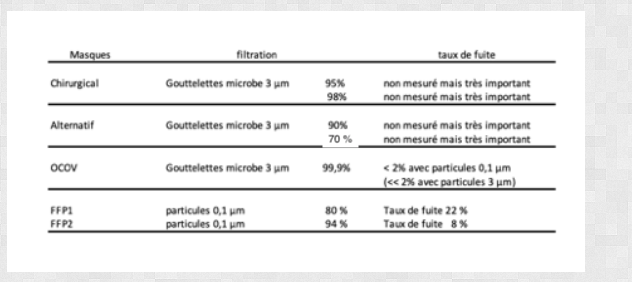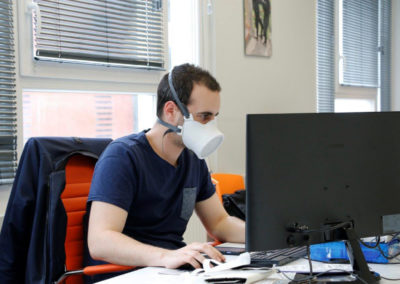What’s this about?
We have talked several times about the effectiveness of masks in protecting against Covid-19. These include type 1 or 2 surgical masks, FFP1, FFP2 and FFP3, FMP1, FMP2 and FMP3 and alternative category 1 or 2 masks!
All the more so since these masks meet different standards whose criteria do not always correspond.
So we decided to consider the case of the SARS-Cov-2 infection and compare the effectiveness of all these masks in protecting us from infection.
Size ratio
The Sars-Cov-2 virus is an organic element with an average size of 100 nm or 0.1 µm.
The virus is never in the air by itself.
Il is transmitted from one individual to another in droplets of secretion (posticles…) emitted from the mouth. These droplets are between 10 µm and 5 µm in size. They are relatively heavy and fall to the ground at a distance of 1 m from the individual.
This is the minimum physical distance for barrier measures.
Very recently, some studies have shown that the virus can also be transmitted in smaller droplets called “aerosols” that range in size from 5 µm to 1 µm. These small droplets, which are lighter than the previous ones, float in the air and are deposited only several metres away, allowing what is called “airborne” transmission of the disease. These aerosols are easily dispersed and appear to play a negligible role in the external environment. However, aerosol contamination is possible in closed environments, especially if there are many people. For this reason, it is now mandatory to wear a mask in closed environments.
The filtration capabilities of the masks and their interest in the Covid-19
The episode of the scramble over the usefulness of masks allowed us to reflect on the properties of the different types of masks to the point of questioning whether the standards are really adequate in the event of an outbreak of a biological nature.
Small review of masks and their standards
- Surgical Mask
Originally intended to protect the operating field from the surgeon’s bronchial secretions (containing germs), the EN 14683 standard measures the mask’s ability to stop bacteria with a diameter of 3 µm, from the inside outwards. Type 1 retains 95% of germs, type 2 retains 98%.
So we are indeed there in the case of protection against biological droplets or aerosols. Two disadvantages however: the measurement is only done in the inside-out direction and there is a very high leakage rate at the face, the mask lets a large amount of air penetrate to the sides and, the mist on the glasses shows that a lot of air comes out directly without passing through the filter. Nevertheless, this mask is a minimum protection so that a contaminated individual does not in turn contaminate another nearby individual. On the other hand, nothing in the standard measures the ability to protect the wearer against drops or aerosols from the outside environment.
- Alternative masks or masks for the general public
In view of the shortage of masks, the health authorities have allowed the use of alternative masks reserved for non-sanitary uses to prevent droplet projections. They are tested by a protocol according to the specifications of the DGA, and a test organization defined with the DGE. They are divided into 2 categories: Cat 1 filtration of at least 90% of biological particles of 3 µm and category 2 filtration greater than 70%. Breathability is also measured.
These masks play the same role as surgical masks.
- FFP(x) masks
FFP masks comply with the EN 149 standard.
Filtration is measured from the outside to the inside of the mask on particles with an average size of 0.1 µm. These particles are not biological but NaCl particles or paraffin particles. The total inward leakage (leak at face level + direct passage through the filter) is also measured.
As previously reported, FFP1 retains 80% of the particles with a leakage rate of 22%, FFP2 retains 94% with a leakage rate of 8%.
From the outset, it can be seen that the test conditions are not suitable for protection against Covid-19, the filtration of 0.1 µm inorganic particles being a great distance from the filtration of 3 µm aqueous biological particles! (in a ratio of 1 to 30).
If we want to compare sizes again, testing a filtration rate on 0.1 µm particles and comparing it to a filtration rate on 3 µm water droplets would come back to using a net whose meshes would stop children’s balls (diameter 1 cm) to stop a football (diameter 30 cm).

- OCOV Mask
Under equivalent test conditions, the OCOV mask retains 99.9% of the 3 µm biological aerosols. Compared to surgical and consumer masks, it filters out the same 3 µm biological particles but with much higher efficiency (99.9% vs. 98% maximum). In addition, its leakage rate has been measured to be less than 2% with 0.1 µm particles, so it is still much lower against larger 3 µm particles. For surgical and consumer masks, leakage rates are not measured because the masks are not adapted to the shape of the face, but some studies have shown that they can reach more than 70%!
The comparison is difficult to make with FFP masks that are tested against particles of different size and structure. For these devices, the filtering capabilities are clearly disproportionate to the size of the drops containing COVID. Moreover, their leakage rates are still significant (22 % and 8 % for FFP1 and FFP2)..

Conclusion
When analyzing the functional capabilities of the masks, we find that
- Surgical masks and alternative masks are effective in preventing the spread of droplets from a sick patient. Effectiveness on the general population can only be achieved if everyone wears such a mask. We have no data on the protection of the wearer against incoming aerosols (except that the leakage rate to the face is very high).
- Masks FFP1 and FFP2 control the incoming and outgoing flows. The filtration measured on non-biological 0.1 µm particles is very good. Leakage rates are significant (22 and 8 % respectively). The high filtration rate, hindering long-term breathing, measured on small particles, seems unsuitable for the capture of aerosol 30 times larger.
- The OCOV mask, which combines excellent filtration adapted to the size of COVID aerosols (99.9% of biological aerosols) and an extremely low leak rate on incoming and outgoing flows, represents the best solution between less filtering and leaking surgical or related masks and FFP masks that are too filtering and therefore less breathable over long periods of time.
Autor: Prof. François Renaud



